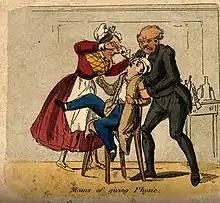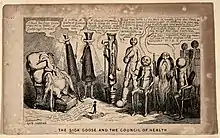Godfrey's Cordial
Godfrey's Cordial was a patent medicine, containing laudanum (tincture of opium) in a sweet syrup, which was commonly used as a sedative to quiet infants and children in Victorian England.[1] Used mostly by mothers working in agricultural groups or industry,[2] it ensured that she could work the maximum hours of her employment, without being disturbed by her infant, and thus increased the family income.[3] It was also used by nurses and baby-minders to enable them to neglect their duties if they wished.[3][4]

Origin and composition
The original formula was named after apothecary Thomas Godfrey of Hunsdon in Hertfordshire. After his death in 1721, without leaving a clear heir to his work,[5] others claimed to have the formula and it was mass-produced across England.[5] Some also ascribed the medicine to Ambroise Hackwitz, also an apothecary, at around the same time, who changed his name to Godfrey and did business in Southampton Row.[1]
Thomas Wakley analysed the formula in 1823, and the ingredients, as he discovered them, were published in The Lancet. They included ginger, rectified spirits of wine, oil of sassafras, tincture of opium and Venice treacle.[5][6] Other preparations have also been suggested, especially in light of the fact that opium was one of the most adulterated drugs in Victorian England.[3] Godfrey's cordial contained about 11⁄4 grain of opium per ounce apothecaries' system (~0.26% by mass) and was readily available without prescription in England and North America.[7][8]
Infant deaths and usage

Godfrey's cordial had long been recognised as leading to fatal cases of opium poisoning.[9]
However, it continued to be made and used until the early twentieth century,[3] at least in part due to the ease with which it could be manufactured. It was reportedly sold in enormous quantities in eighteenth century England,[1][8] a time-span that has been popularly referred to as the golden age of physic, due to the widespread availability and consumption of enormous amounts of proprietary medicines.[10] Its low cost[11] and a lack of public knowledge about infant management[3] further increased its popularity.
Though many cases of infant death had been conclusively linked to an indiscriminate use of the medicine by mothers and nurses,[1][5][7][12] exact numbers are hard to ascertain.[3][11] Those who survived often, reportedly, had a severely damaged physical constitution.[3]
Decline
In 1857, with ill-advised opioid usage reaching alarming levels, a parliamentary bill was put forward which classified opium and its derivatives as poisons. This was intended to severely restrict the sale of such compounds, but it failed to pass through parliament, after being subject to intensive lobbying by trading chemists. It was also widely criticised as an impractical solution from an overall perspective.[3] A much-diluted version of the original proposed bill was finally implemented as the Pharmacy Act 1868 which limited the sale of opium derivatives to registered chemists and legally qualified apothecaries.[8] It explicitly excused patent medicines (and thus Godfrey's Cordial) from its purview.[3]
Usage of Godfrey's Cordial gradually declined post-1890 as several court rulings held that the act applied equally to patent medicines[3] and the British Medical Association subsequently published lists of safe home remedies, in a bid to increase public health awareness, which mentioned calomel and sugar-based derivatives as substitute sedative agents. Finally, the Pharmacy Act 1908, which classified it as a Schedule-I poison,[3] followed by the Dangerous Drugs Act 1920 which mandated a medical prescription,[8] heavily restricted the availability and usage of any such opioid-based drug.
References
- Jordan, Thomas E. (1 February 1987). "The Keys of Paradise: Godfrey's Cordial and Children in Victorian Britain". Journal of the Royal Society of Health. 107 (1): 19–22. doi:10.1177/146642408710700109. ISSN 0264-0325. PMID 3102733. S2CID 9759769.
- Parssinen, Terry M. (1983). Secret Passions, Secret Remedies: Narcotic Drugs in British Society, 1820-1930. Manchester University Press. ISBN 9780719009525.
- Lomax, Elizabeth (1973). "The Uses and Abuses of Opiates in Nineteenth-Century England". Bulletin of the History of Medicine. 47 (2): 167–176. JSTOR 44447528. PMID 4584236.
- Parssinen, Terry M. (1983). Secret Passions, Secret Remedies: Narcotic Drugs in British Society, 1820–1930. Manchester University Press. ISBN 9780719009525.
- Corley, T. (3 January 2008). "Godfrey, Thomas (d. 1721)". Oxford Dictionary of National Biography (online ed.). Oxford University Press. doi:10.1093/ref:odnb/58753. ISBN 978-0-19-861412-8. (Subscription or UK public library membership required.)
- Berridge, Virginia; Edwards, Griffith (1981), Opium and the People: Opiate Use in Nineteenth-Century England, A. Lane, p. 98, ISBN 9780713908527
- C., T. E. (1 July 1981). "Overdosing with Opium, a Serious Pediatric Problem in England a Century and a Half Ago". Pediatrics. 68 (1). ISSN 0031-4005.
- Milner, Larry Stephen (2000). Hardness of Heart/hardness of Life: The Stain of Human Infanticide. University Press of America. ISBN 9780761815785.
- C., T. E. (1 June 1970). "What were Godfrey's Cordial and Dalby's Carminative?". Pediatrics. 45 (6). ISSN 0031-4005.
- Kelly, James (2008). "Health for sale: mountebanks, doctors, printers and the supply of medication in eighteenth-century Ireland". Proceedings of the Royal Irish Academy, Section C: Archaeology, Celtic Studies, History, Linguistics, Literature. 108C: 75–113. doi:10.3318/PRIAC.2008.108.75. JSTOR 40657923.
- Jordan, Thomas Edward (1987). Victorian Childhood: Themes and Variations. SUNY Press. ISBN 9780887065446.
- "Death from Godfrey's Cordial". The Lancet. 140 (3610): 1061. 5 November 1892. doi:10.1016/S0140-6736(01)92752-7. ISSN 0140-6736.